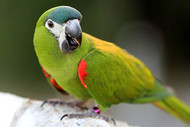Hahn's Macaw Fact Sheet
Posted by Hahn’s Macaw Parrots, Hahn’s Macaw Facts, Hahn’s Macaw Training, Hahn’s Macaw Diet, Hahn’s Macaw Breeding on 9/1/2024
Rosemary Low explains more about the Hahn?s Macaw in her fact sheet.
Scientific name
Diopsittaca nobilis nobilis
Common name(s)
Hahn?s or Red-shouldered Macaw
Adult length
31cm (12in)
Adult weight
About 165g.
Potential lifespan
About 30 years.
Status in wild
Common.
Find lots of Hahn?s Macaw goodies here.
Origin
North-eastern South America
Where Hahn?s Macaws live
The smallest of the Macaw?s, Hahn?s is an endearing character with much to recommend it. In size and breeding biology, this Macaw is more closely aligned with the Conures.
Indeed, if its lores had been feathered it would no doubt have been classified as one.
Immature Plumage
With the exception of the Red-fronted Macaw (Ara rubrogenys), this is the only Macaw in which immature plumage differs noticeably from that of adults. Young birds have the bend of the wing green and the under wing coverts mainly green or margined with red. In adults the bend of the wing and the under wing coverts are red. On fledging the beak is partly grey or horn-coloured and the eye and cere are lighter than in adults.
Suitability
While the large Macaws cannot be recommended as household pets, due to their large size and extreme destructiveness, this species is of a more manageable size for the home. It is not perfect because its voice is loud.
?However, if it receives a lot of attention and stimulation in the form of things to keep it occupied, the noise level should be acceptable. However, those considering acquiring this species are advised to familiarise themselves with an adult?s vocalisations before purchase.
There is one sub-species, the Noble Macaw (D.n.cumanensis) distinguished by its white upper mandible. It is rare in aviculture as it originates from Brazil. (There has been no legal export from that country for more than 50 years.)
Availability
Hahn?s Macaw was exported in large numbers into Europe from Guyana, until importation of wild-caught Parrots ceased in 2005 due to avian influenza. Young, hand-reared birds bred in the UK are usually available during the summer and autumn months.
Breeding
Since the early 1990s it has become well established in aviculture due to its prolific nature. Its great advantage is that it will breed successfully on the colony system. Be warned, however! The success of any parrot breeding colony depends on never removing or adding any adult birds. The young reared will be accepted as members of the flock, but introduce a stranger and it is likely to be attacked.
If you plan to colony breed, collect your founder stock then place them all in the aviary at the same time. Ideally they would be young birds from several unrelated pairs. They are sexually mature at only two years old. Hahn?s lay large clutches, usually of four or five eggs, even six, at intervals of two days. The incubation period is 24 days. Young leave the nest at seven and a half to eight weeks of age.
Training
Because there is a demand for this species for the pet trade, most breeders hand-rear the young. Hand-reared Hahn?s tend to be quite demanding and unless taught the usual commands (such as ?Step up!?) from an early age will soon try to dominate humans. It is essential that a young bird is taught this, especially as I would never recommend wing-clipping.
All young Parrots have a great need to fly and if prevented from doing so, not only will their muscles fail to develop properly (possibly making flight in later years impossible) but psychological problems such as feather plucking can result.
Note that a parent-reared bird will be less dependent on human company and better able to amuse itself if left alone. It should therefore be less noisy than a more demanding hand-reared youngster. If removed from the parents about four weeks after leaving the nest, its pet potential will be good in the hands of a patient person who enjoys the challenge of taming. This is achieved by spending much time talking to it and not handling it until it is confident.
Mimicry
Some birds learn to repeat a few words and various sounds ? but don?t expect this species to acquire a large vocabulary, like an Amazon, for example.
Diet
Hahn?s Macaws are easy to feed. A quality Parrot mixture that contains a good variety of items should be offered, avoiding those that contain cheap fillers like hard maize and flaked peas ? inedible to most Parrots.
They enjoy spray millet. They will consume various vegetables, cooked maize and fresh corn, green beans, the berries of hawthorn and all the usual fruits. When chicks are in the nest an egg rearing food can be offered with the addition of frozen (thawed) mixed vegetables sprinkled with a calcium supplement.
Young, tender corn on the cob will be greatly appreciated, especially by recently fledged or hand-reared young at the weaning stage. Sprouted sunflower seed that has just started to germinate is another excellent food.
There is lots of yummy Hahn?s Macaw food here.
If you have any comments about this post, please leave your thoughts for others below?
Browse the big choice of Hahn?s Macaw products here.




